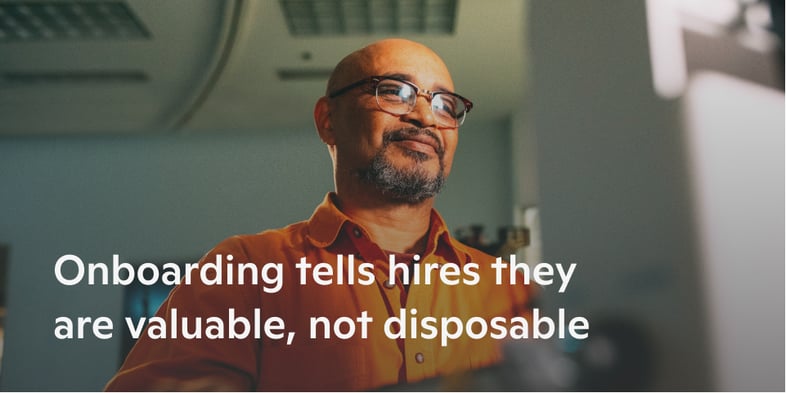FACT: Onboarding is neglected all too often
Here’s why effective onboarding is important
Imagine you’ve boarded an overnight flight. Reclining into your seat, feet up, you order a glass of your favorite beverage. Your equilibrium ends with a jolt - the plane dips, almost knocking over a flight attendant.
“Did we hit turbulence?” You ask.
The terse attendant explains the airline’s policy - their pilots train on-the-job. At the controls is a person who has, until today, never flown a plane in their life.
Talk about a cautionary customer experience. I wouldn’t blame you if, next time, you took the train.
This is not fantasy.
About a third of businesses do not offer a formal onboarding program. In them, new hires prep’ food, manage inventories, and work production lines, with no idea what they’re doing or why (1). They're told to muddle through; encumbered with responsibility before they're taught the basics. True, you won’t run into any pilots trained on the job. Yet you will at some point receive (poor) services from hires that had no onboarding at all. As double standards go, this one is maddening.
Trial-by-fire razes companies to the ground. This is unsurprising, as absent onboarding makes for scared, underprepared hires. The predictable result is high staff churn rates and poor engagement. Manufacturing and retail are particular sufferers. Remember, low engagement wastes 1.8 trillion dollars of yearly revenue in the US alone. (2) That’s a catastrophic waste of value - to say nothing of the ethical cost of disillusioning your workforce.
These factors paint a bleak reality. Even today, many companies regard the onboarding experience as a sink-or-swim afterthought. Instead, hires study by example - from veteran staff who have other commitments. New hires lack insight into the company’s culture, goals, or workflow, beyond figuring out as they go along.
Look, it’s a fact that first impressions last. If a hire leaves their first shift feeling overwhelmed, they likely won't stay for long.
Misconceptions abound about onboarding, and that’s causing companies to leave money in the lurch. Let’s take a look at three facts of life that make a successful onboarding program - and how to implement them.
FACT: There are few bad hires, only bad onboarding
How onboarding can cut churn and raise wellbeing
There’s nothing worse than joining a company that claims to have hired you for a reason, only to feel pointless. If that situation rings familiar, then, at some point in your career, you were labeled as a ‘bad hire’.

95% of companies admit to making bad 'hires'(3); the employees that pass interview, then struggle to perform. Many companies blame bad hires for high turnover - and leave it at that.
That story is convenient, but it’s not true. It doesn’t offer potential solutions other than ever-intensified screening. This is not a real solution while the world is being gripped by a talent shortage.(4)
Poor onboarding creates ‘bad’ hires from inspired applicants. That assertion makes sense when you look at the numbers. A 2008 study, in the UK and USA, discovered over 37 billion dollars squandered from the economy every year. The shocking cause: employees misunderstanding their roles. (5) That number has only gone up since then. That’s a thunderous amount of reclaimable value lost. Poof - gone.
Cognisco's more contemporary analytics tell us 50% of employees lack competence or confidence. In Cogniso's own words, they "need guidance" to achieve their potential. In consequence, thrifty employers stand to benefit by investing in employee onboarding. That’s not to mention the obvious safety risks associated with poor training.
One pernicious misconception is that onboarding is only about getting hires to work. Far from it - onboarding is a company’s chance to foster community between hires and itself. As gallup notes, most people switch jobs to find wellbeing. Remember, hires aren’t only signing a legal contract - they’re signing an emotional contract, too. Thus, an effective onboarding tells hires about your organization's mission. It's a home truth that hires who feel they belong at work, are productive at work. (6)

The best way to help new hires belong is to help them prepare, ahead of day one. A good onboarding program will list the resources a hire will need to use, before they walk through the door. One way to achieve this is by hosting guidance on an onboarding app. For example, fashion retailers use this to teach personal presentation to new staff. Restauranteurs use apps to share advice and events and between locations. Floor salesmen use it to celebrate successes. This places your company’s mission-statement front and centre, by aligning the hire’s way of thinking with their wider community of employees.
FACT: Onboarding is about access, not authority
How to remember training - without leaning on a supervisor
“Waiting for information” at work incurs a cost - averaging 5,320 dollars lost, per worker, per year. (7) This means, over a three year tenure, companies waste enough money to buy a midrange motorcycle. That ‘information debt’ often comes at the start of a new job, when hires often feel out of their depth.

Memory recall studies show employees feel they only remember around 37% of their meetings. (8) Imagine you're a new hire, and your onboarding program is a mishmash of meetings. You’re only going to remember less than a third of the information you'll need to do your job. I hope you can think on your feet!
Some companies try to steer around the iceberg of forgetfulness with half-measures. They cram onboarding into monolithic briefings, under the watchful eyes of experienced staff. Yet there’s a reason why probation periods exist; acclimating to new positions incurs a time debt. There isn’t enough time teach every useful skill in a few briefings. Instead, applied skills develop over the first few months of work. In that sea of information, it’s unsurprising that the odd lecture will sink out of the memories of your hirees.
Yet HR departments often assume ‘onboarding’ is a one-time act. Once you’ve finished all the briefings, check-ins, and guidebooks, you're up to speed. There's no further need to go over old lessons.
As you've likely guessed, that isn't correct. Most onboarding info (à la safety information, or handbooks), doesn't lose relevance over time. Revision is key, and a sustainable onboarding program will allow a hire to revise old lessons.
But one-to-one supervisor time is a limited resource. Thus, In the 2020s, a digital alternative is often not only a good option, but a better choice. Yet now we know the 'why', we should be careful with the 'how'. Dumping teachable information in forgettable email attachments won't cut it for effective revision. Emails come with no guarantee that the recipient is reading anything they open - and they’re easy to lose track of.
Make this your motto; accessible is memorable. A digital onboarding app, on mobile, PC, or tablet, combines oversight with convenience. Remember, hires often need to check procedure at short notice. Let's say a potential customer asks a question - and your hire needs to get them an answer as fast as possible. With their onboarding info on an app, a new hire can get needed info without calling their supervisor.
FACT: Onboarding is for careers, not the first day
How pre-boarding can inspire new hires to excel
There are retail executives out there, who started their career in mom-and-pop grocery stores. Massive career mobility can happen for frontliners - and it starts the moment you take in a new hire.

Of course - you know that. The question stands: do your hires know?
It’s a sad reality that many new hires believe frontline work won’t offer them career growth. They see their roles as temporary stepping-stones, replaceable with part-timers. This misconception pushes much-needed talent out of frontline positions. Unfortunately, this misconception isn’t exclusive to the frontline. Harvard Business Review shows, ironically, this deception is sometimes perpetuated by C-level. (9) The sad result is poor customer service - and dovetailing profit margins.
Motivating onboarding can turn a frontliner's job into a career. To do that, an onboarding program should help hires share their employer’s goals. One way can be through courses - taught in guidebooks attached to an onboarding checklist. Another is through organic engagement - for example, news updates and team success stories in the workplace's news app. The thread linking these together is -inspiration-. New hires must believe their team members are agents of inspired change. They need to see that their employee experience, (and their progress), reaps rewards.

In short, employers should make core values clear to your hires. This is more than employee branding, but an earnest investment in esprit de corps. As SHRM notes, the sooner new hires feel welcome, the sooner they can “contribute to the firm’s mission”. (10) A successful pre-boarding program is thus one that communicates the company's ideology and purpose.
Preboarding should show the big picture: was one of your founders once a frontline worker? If so, share that info. Do you have any sustainability initiatives in place? Great! Then tell your new hires. Is your company seeking to do good in the world? Let your employees know - lofty goals shouldn’t sit in the silo at C’level.
The opposite is also true - a manager’s impression of a hire will shape the hire’s standing in that team. Research shows that manager - hire understanding is make-or-break for job satisfaction. (11) So, an effective onboarding program should teach managers about their new staff. One way to achieve this is to question the employee through their onboarding app. Asking the employee to write about themselves helps managers understand their personality. This is great for pre-empting any flashpoints, while building team spirit.
In consequence, a well-designed onboarding program sets testable challenges before actual work commences. One option is onboarding quizzes. Through the resulting analytics, managers can see which hires accessed training guidance. This gives a sense of a new team's knowledge set right from the outset, reducing back-and-forth.
Remember, three quarters of companies believe a digitalized system would improve their onboarding. Yet, only 20% of companies have actually adopted one. (12) In effect, the companies that invest in digital onboarding today will leap ahead of the curve.
Sources
Study for ‘CareerBuilder’, conducted by Harris Poll. Samples over 2300 hiring managers and human resource professionals. (1)
2019 infographic aggregating productivity prohibitors, from SUREPAYROLL (2)
’The True Cost of a Bad Hire’ By: Madeline Laurano, VP and Principal Analyst, Talent Acquisition Brandon Hall Group, hosted by Glassdoor. (3)
Infographic data from ‘Go.Manpower Group’. (4)
'$37 billion: Counting the cost of employee misunderstanding' by Cogniso. (5)
Inclusion And Belonging – ’The Value of Belonging at Work’, by Evan W. Carr, Andrew Reece, Gabriella Rosen Kellerman, and Alexi Robichaux, Harvard Business Review (6)
‘Your business case for internal communications’ - The Grossman group factsheet, (7)
’Augmenting Memory Recall in Work Meetings: Establishing a Quantifiable Baseline’ - By Evangelos Niforatos, Agon Bexheti, Matías Laporte, Marc Langheinrich, of the Università della Svizzera italiana (8)
Human Resource Management, Why “Good Jobs” Are Good for Retailers, by Zeynep Ton, Harvard Business Review. (9)
SHRM Foundation’s Effective Practice Guidelines Series ‘Onboarding New Employees: Maximizing Success’By Talya N. Bauer,Ph.D (10)
Contains discreet data and assertions sourced from Relesys


-Jan-17-2023-01-17-53-1140-PM.jpeg)


